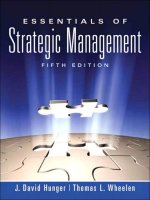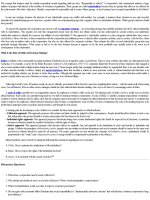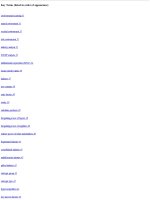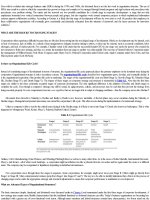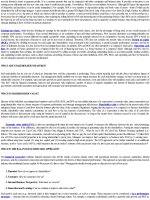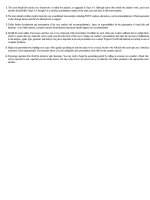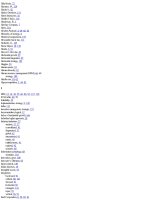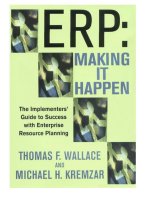Essentials of Strategic Management The Quest for Competitive Advantage_1 pptx
Bạn đang xem bản rút gọn của tài liệu. Xem và tải ngay bản đầy đủ của tài liệu tại đây (441.73 KB, 26 trang )
页码,1/1
6/26/2003file://C:\Documents%20and%20Settings\Administrator\桌面\erp.jpg
TEAMFLY
Team-Fly
®
ERP:
Making It
Happen
The Implementers’ Guide to
Success with Enterprise
Resource Planning
Thomas F. Wallace
Michael H. Kremzar
John Wiley & Sons, Inc.
New York • Chichester • Weinheim • Brisbane • Singapore • Toronto
Copyright © 2001 by Thomas F. Wallace
and Michael H. Kremzar. All rights reserved.
Published by John Wiley & Sons, Inc.
Published simultaneously in Canada.
No part of this publication may be reproduced, stored in a retrieval
system or transmitted in any form or by any means, electronic,
mechanical, photocopying, recording, scanning or otherwise, except as
permitted under Sections 107 or 108 of the 1976 United States Copyright
Act, without either the prior written permission of the Publisher, or
authorization through payment of the appropriate per-copy fee to the
Copyright Clearance Center, 222 Rosewood Drive, Danvers, MA 01923,
(978) 750-8400, fax (978) 750-4744. Requests to the Publisher
for permission should be addressed to the Permissions Department,
John Wiley & Sons, Inc., 605 Third Avenue, New York, NY 10158-0012,
(212) 850-6011, fax (212) 850-6008, E-Mail:
This publication is designed to provide accurate and authoritative
information in regard to the subject matter covered. It is sold with
the understanding that the publisher is not engaged in rendering
professional services. If professional advice or other expert assistance
is required, the services of a competent professional person
should be sought.
This title is available in print as ISBN 0-471-39201-4
For more information about Wiley products, visit our web site
at www.Wiley.com
iii
Contents
Acknowledgments vii
How to Use This Book xi
PART I—INTRODUCTION
C
HAPTER
1
Enterprise Resource Planning 3
C
HAPTER
2
The Implementation Challenge 23
PART II—COMPANY-WIDE IMPLEMENTATION
C
HAPTER
3
Company-Wide Implementation—Overview 43
C
HAPTER
4
Software 57
C
HAPTER
5
Getting Ready 79
C
HAPTER
6
Project Launch 109
iv Contents
C
HAPTER
7
Initial Education 135
C
HAPTER
8
Sales & Operations Planning 165
C
HAPTER
9
Process Definition 179
C
HAPTER
10
Data Integrity 195
C
HAPTER
11
Going on the Air—Basic ERP (Phase I) 219
C
HAPTER
12
Going on the Air—Supply Chain Integration (Phase II) 243
PART III—QUICK-SLICE IMPLEMENTATION
C
HAPTER
13
Quick-Slice ERP—Overview 271
C
HAPTER
14
Quick-Slice ERP—Implementation 281
PART IV—BEYOND ERP IMPLEMENTATION
C
HAPTER
15
Operating ERP 305
C
HAPTER
16
The Strategic Future (Phase III) 319
A
PPENDIX
A
The Fundamentals of Enterprise Resource Planning 333
A
PPENDIX
B
Plant Floor Organization Formats:
Job Shop versus Flow Shop 341
A
PPENDIX
C
Sample Implementation Plan 347
A
PPENDIX
D
ERP Support Resources 349
Glossary 351
Index 365
Contents v
There are so many people to acknowledge when a book like this is
complete. All of those who contributed to the earlier MRPII book
certainly played a role, albeit indirect, in this new effort. Many oth-
ers who are active in the field provided insight through their books,
papers, or talks. For sake of brevity, we are going to focus on this
book and hope that all of those who built the foundation of the ear-
lier works will still feel ownership for this one.
As the final draft developed, we asked a handful of people to help
us with input on the quality of our effort. Their insightful feedback
has been extremely important.
Gary Abyad Jerry Clement
Chief Operating Officer Principal
Clopay Plastic Products The Oliver Wight
Company Companies
Mike Friedman Chris Gray
Director of Product Supply Principal
The Procter & Gamble Gray Research
Company
Mike Landrigan Jim Rice
Chief Financial Officer Leader, MIT Integrated
Innotek, Inc. Supply Management
Program
vii
Travis Rushing Bob Stahl
Director, Commercial Principal
Products Product Supply Partners In Excellence
The Procter & Gamble
Company
Our sincere thanks go to all of you for taking the time to pour over
the manuscript and pouring your insights into comments—some-
times painful but always helpful. Thanks also to the folks at the
APICS Region III Officers Meeting in January, 2001 for their valu-
able feedback.
There are two individuals who need to be highlighted since they
did so much to pave the way for what all of us are doing today. The
late Oliver Wight must be credited for developing most of the con-
cepts in resource planning still in use today. Ollie certainly was an
inspiration for much that has followed. Also, Darryl Landvater
developed the Detailed MRPII Implementation Plan that was fea-
tured in the earlier works and now continues to be utilized in this
book. We owe much to these two as well as many others at the Oliver
Wight Companies who have done such good work in developing the
widespread understanding of resource planning.
In this book, we quote from an excellent work by Thomas H.
Davenport, Mission Critical—Realizing the Promise of Enterprise
Systems. For those digging more deeply into issues related to
enterprise-wide software, we highly recommend this book. Also,
Professor Jeanne W. Ross, Center for Information Systems Research
at MIT, shared her thoughts with us on ERP. Both of these sources
were helpful as we wrestled with how best to present the software
side of the ERP equation.
We need to recognize our families for their support and comfort
during this effort. Marilyn Kremzar has been putting up with the
frustrations of living with Mike throughout his entire career with
P&G and now during this book as well. Yes, Marilyn, Mike will re-
tire one of these days! Tom acknowledges the enormous contri-
butions of his wife of 38 years, Evelyn, in this and so many other
projects during that time. She died during the writing of this book.
Last, and most assuredly not least, we’re deeply indebted to the
users, the people in manufacturing companies who’ve made resource
planning work. The early implementers in particular displayed great
viii Acknowledgments
vision and courage to persevere, to take two steps forward and then
maybe one step back, to keep the faith and to make it happen.
Thanks largely to them, a trial-and-error approach to implementing
ERP is no longer necessary.
Thomas F. Wallace
Michael H. Kremzar
Cincinnati, Ohio
Acknowledgments ix
TEAMFLY
Team-Fly
®
How to Use This Book
The intended audience for this book comes primarily from compa-
nies in two categories:
Companies that recognize the need for better decision-making pro-
cesses, enhanced coordination, and greater responsiveness both
internally and within their extended supply chain
Companies that have installed an enterprise-wide software system
and now realize that they need to change their businesses pro-
cesses to gain major benefits from their investment in software.
The people who should read all or part of this book include:
The executive in charge of the entire business unit (general manager,
president, chief executive officer): Read at a minimum Chapters 1,
2, and 3 to understand the basic concepts of ERP and the scope of
the project. It should prove helpful to read Chapter 8 on Sales &
Operations Planning and Chapter 13 on an implementation ap-
proach called Quick Slice. Finish with Chapter 16 for some insight
into the full potential of ERP, which is enormous.
The chair of the executive steering committee (described in Chapter
6): Read all chapters.
Members of the executive steering committee (described in Chapter
6): Read Chapters 1, 2, 5, 6, and 7 and the part of Chapter 11 that
xi
deals with implementing Sales & Operations Planning. Further, if
implementation is being done on a Quick-Slice basis (defined in
Chapter 2), they should read Chapters 13 and 14. Here also, Chap-
ter 16 should prove to be of interest.
All members of the ERP Project Team: Read all chapters.
We prepared this book to be useful either as selective reading for
those who need only specific pieces of information, or as a virtual
checklist for those who need to know every step. Those of us who
have been through ERP implementations with the Second Edition of
this book have found that it was the book most often referred to.
Even after the project is well underway, we suspect you’ll probably
find yourself opening this book and referring to specific subjects.
Lastly, while this book does cover every aspect of implementing
ERP, it does not tell you every step, every report, or every piece of
data required. You will need more than this one book to do the en-
tire project. Our job here has been to give you the working knowl-
edge to know what needs to be done. Each company will design the
details of the project to reflect its individual business, people, and
challenges but the implementation path described here is for every
company.
Go make it happen!
xii How to Use This Book
PA R T I
Introduction
Enterprise Resource
Planning
This is not a book about software. One more time: This is not a book
about how to select software and install it on your computers. Rather,
it’s a book about how to implement superior business processes in
your company—processes that yield a competitive advantage.
Right now you might be thinking: “Wait a minute. The name of
this book is ERP. How can it not be about software?”
The answer is that Enterprise Resource Planning (ERP) is not
software. One more time: ERP is not software. There’s a lot of sloppy
terminology flying around today in the business press, and one mis-
nomer is to label enterprise-wide transaction processing software
systems as ERP. These software packages support effective resource
planning and make much of it feasible, but they don’t truly do it. Plus
these packages contain many business processes other than resource
planning.
Therefore, we need to trot out another acronym that does refer to
software: ES. This stands for Enterprise System or Enterprise Soft-
ware. In his book Mission Critical,
i
author Thomas H. Davenport de-
scribes enterprise systems as “packages of computer applications that
support many, even most, aspects of a company’s information needs.”
That makes sense to us. Now for another distinction: Not all ERP
business functions are contained in the typical Enterprise Software
3
(ES) suite. Similarly, the typical ES contains software support for
business processes that are not a part of ERP. In Figure 1-1, we can
see that distinction graphically. Please note the three areas on that di-
agram. The rightmost part of the figure refers to those functions con-
tained within a typical ES that are not part of ERP; the leftmost area
is for those ERP functions not normally supported by an ES; the
area of overlap in the center references those ERP functions typi-
cally supported by Enterprise Software.
Now let’s take a look at just what this ERP thing is all about.
W
HAT
I
S
E
NTERPRISE
R
ESOURCE
P
LANNING
A
ND
W
HAT
D
OES
I
T
D
O
?
Enterprise Resource Planning (ERP)—and its predecessor, Manu-
facturing Resource Planning (MRP II)—is helping to transform our
industrial landscape. It’s making possible profound improvements in
4 ERP: M I H
ERP PROCESSES
NOT PART OF A
TYPICAL ES:
Sales Forecasting
Sales and Operations Planning
Advanced Planning Systems
Supplier Rating Systems
Performance Metrics
ERP PROCESSES
FOUND IN A
TYPICAL ES:
Master Production Scheduling
Rough-Cut Capacity Planning
Material Requirements Planning
Capacity Requirements Planning
Distribution Requirements Planning
Customer Order Entry and Promising
NON-ERP PROCESSES
FOUND IN A
TYPICAL ES:
Accounts Receivable
Accounts Payable
General Ledger
Cash Management
Customer Relations Management
Human Resources
Data Warehousing
E
R
P
E
S
Figure 1-1
ERP Processes
the way manufacturing companies are managed. It is a strong con-
tributor to America’s amazing economic performance of the 1990s
and the emergence of the New Economy. A half century from now,
when the definitive industrial history of the twentieth century is writ-
ten, the evolution of ERP will be viewed as a watershed event. Let’s
describe Enterprise Resource Planning as:
An enterprise-wide set of management tools that balances de-
mand and supply,
containing the ability to link customers and suppliers into a com-
plete supply chain,
employing proven business processes for decision-making, and
providing high degrees of cross-functional integration among
sales, marketing, manufacturing, operations, logistics, purchasing,
finance, new product development, and human resources, thereby
enabling people to run their business with high levels of customer
service and productivity, and simultaneously lower costs and in-
ventories; and providing the foundation for effective e-commerce.
Here are some descriptions of ERP, not definitions but certainly
good examples.
Enterprise Resource Planning is a company increasing its sales by
20 percent in the face of an overall industry decline. Discussing how
this happened, the vice president of sales explained: “We’re captur-
ing lots of business from our competitors. We can out-deliver ’em.
Thanks to (ERP), we can now ship quicker than our competition,
and we ship on time.”
Enterprise Resource Planning is a Fortune 50 corporation achiev-
ing enormous cost savings and acquiring a significant competitive
advantage. The vice president of logistics stated: “ERP has provided
the key to becoming a truly global company. Decisions can be made
with accurate data and with a process that connects demand and
supply across borders and oceans. This change is worth billions to us
in sales worldwide.”
Enterprise Resource Planning is a purchasing department gen-
Enterprise Resource Planning 5
erating enormous cost reductions while at the same time increasing
its ability to truly partner with its suppliers. The director of purchas-
ing claimed: “For the first time ever, we have a good handle on our fu-
ture requirements for components raw and materials. When our
customer demand changes, we—ourselves and our suppliers—can
manage changes to our schedules on a very coordinated and con-
trolled basis. I don’t see how any company can do effective supply
chain management without ERP.”
That’s ERP. Here’s how it came to be.
T
HE
E
VOLUTION OF
E
NTERPRISE
R
ESOURCE
P
LANNING
Step One—Material Requirements Planning (MRP)
ERP began life in the 1960s as Material Requirements Planning
(MRP), an outgrowth of early efforts in bill of material processing.
MRP’s inventors were looking for a better method of ordering mate-
rial and components, and they found it in this technique. The logic
of material requirements planning asks the following questions:
• What are we going to make?
• What does it take to make it?
• What do we have?
• What do we have to get?
This is called the universal manufacturing equation. Its logic ap-
plies wherever things are being produced whether they be jet aircraft,
tin cans, machine tools, chemicals, cosmetics or Thanksgiving
dinner.
Material Requirements Planning simulates the universal manu-
facturing equation. It uses the master schedule (What are we going
to make?), the bill of material (What does it take to make it?), and in-
ventory records (What do we have?) to determine future require-
ments (What do we have to get?).
For a visual depiction of this and the subsequent evolutionary
steps, please see Figure 1-2, a modified version of a diagram in Carol
Ptak’s recent book on ERP.
ii
6 ERP: M I H
Step Two—Closed-Loop MRP
MRP quickly evolved, however, into something more than merely a
better way to order. Early users soon found that Material Require-
ments Planning contained capabilities far greater than merely giving
better signals for reordering. They learned this technique could help
to keep order due dates valid after the orders had been released to
production or to suppliers. MRP could detect when the due date of
an order (when it’s scheduled to arrive) was out of phase with its need
date (when it’s required).
Enterprise Resource Planning 7
Figure 1-2
ERP
MRP II
Closed-Loop MRP
MRP
EVOLUTION OF ERP
This was a breakthrough. For the first time ever in manufacturing,
there was a formal mechanism for keeping priorities valid in a con-
stantly changing environment. This is important, because in a man-
ufacturing enterprise, change is not simply a possibility or even a
probability. It’s a certainty, the only constant, the only sure thing.
The function of keeping order due dates valid and synchronized with
these changes is known as priority planning.
So, did this breakthrough regarding priorities solve all the prob-
lems? Was this all that was needed? Hardly. The issue of priority is
only half the battle. Another factor—capacity—represents an
equally challenging problem. (See Figure 1-3.)
Techniques for helping plan capacity requirements were tied in
with Material Requirements Planning. Further, tools were devel-
oped to support the planning of aggregate sales and production lev-
els (Sales & Operations Planning); the development of the specific
build schedule (master scheduling); forecasting, sales planning, and
customer-order promising (demand management); and high-level re-
source analysis (Rough-Cut Capacity Planning). Systems to aid in exe-
cuting the plan were tied in: various plant scheduling techniques for
the inside factory and supplier scheduling for the outside factory —
the suppliers. These developments resulted in the second step in this
evolution: closed-loop MRP. (See Figure 1-4.)
Closed-loop MRP has a number of important characteristics:
It’s a series of functions, not merely material requirements planning.
It contains tools to address both priority and capacity, and to sup-
port both planning and execution.
It has provisions for feedback from the execution functions back to
the planning functions. Plans can then be altered when necessary,
thereby keeping priorities valid as conditions change.
8 ERP: M I H
Figure 1-3
Priority vs. Capacity
Priority Capacity
Which ones? Enough?
Sequence Volume
Scheduling Loading
TEAMFLY
Team-Fly
®
Step Three—Manufacturing Resource Planning (MRP II)
The next step in this evolution is called Manufacturing Resource
Planning or MRP II (to distinguish it from Material Requirements
Planning, MRP). A direct outgrowth and extension of closed-loop
MRP, it involves three additional elements:
1. Sales & Operations Planning—a powerful process to balance
demand and supply at the volume level, thereby providing top
management with far greater control over operational aspects
of the business.
2. Financial interface—the ability to translate the operating
plan (in pieces, pounds, gallons, or other units) into financial
terms (dollars).
3. Simulation—the ability to ask “what-if” questions and to ob-
tain actionable answers—in both units and dollars. Initially
Enterprise Resource Planning 9
Figure 1-4
CLOSED-LOOP MRP
DEMAND SUPPLY
PRODUCTION
PLANNING
MASTER
SCHEDULING
MATERIAL
REQUIREMENTS
PLANNING
PLANT &
SUPPLIER
SCHEDULING
EXECUTION
D
E
M
A
N
D
M
A
N
A
G
E
M
E
N
T
C
A
P
A
C
I
T
Y
P
L
A
N
N
I
N
G
this was done only on an aggregate, “rough-cut” basis, but to-
day’s advanced planning systems (APS) enable effective simu-
lation at very detailed levels.
Now it’s time to define Manufacturing Resource Planning. This
definition, and the one to follow, come from APICS—The Educa-
tional Society for Resource Management. APICS is the leading pro-
fessional society in this field, and its dictionary has set the standard
for terminology over the years.
MANUFACTURING RESOURCE PLANNING (MRP II)—
A method for the effective planning of all resources of a manufac-
turing company. Ideally, it addresses operational planning in
units, financial planning in dollars, and has a simulation capabil-
ity to answer “what-if ” questions. It is made up of a variety of
functions, each linked together: business planning, sales and op-
erations planning, production planning, master scheduling, mate-
rial requirements planning, capacity requirements planning, and
the execution support systems for capacity and material. Output
from these systems is integrated with financial reports such as the
business plan, purchase commitment report, shipping budget, and
inventory projections in dollars. Manufacturing resource plan-
ning is a direct outgrowth and extension of closed-loop MRP.
iii
Step Four—Enterprise Resource Planning (ERP)
The latest step in this evolution is Enterprise Resource Planning
(ERP). The fundamentals of ERP are the same as with MRP II. How-
ever, thanks in large measure to enterprise software, ERP as a set of
business processes is broader in scope, and more effective in dealing
with multiple business units. Financial integration is even stronger.
Supply chain tools, supporting business across company boundaries,
are more robust. For a graphical view of ERP, see Figure 1-5.
Let’s now look at a complete definition of ERP, based on the de-
scription we saw a few pages back:
ENTERPRISE RESOURCE PLANNING (ERP) predicts and
balances demand and supply. It is an enterprise-wide set of fore-
casting, planning, and scheduling tools, which:
10 ERP: M I H
Figure 1-5
ENTERPRISE RESOURCE PLANNING
STRATEGIC PLANNING
BUSINESS PLANNING
VOLUME
SALES & OPERATIONS
PLANNING
SALES
PLAN
OPERATIONS
PLAN
MIX
MASTER SCHEDULING
DETAILED PLANNING &
EXECUTION PROCESSES:
MRP, PLANT SCHEDULING,
SUPPLIER SCHEDULING, ETC.
DEMAND SUPPLY
C
A
P
A
C
I
T
Y
P
L
A
N
N
I
N
G
F
O
R
E
C
A
S
T
I
N
G
A
N
D
D
E
M
A
N
D
M
G
M
T
EXECUTION
Enterprise Resource Planning 11
• links customers and suppliers into a complete supply chain,
• employs proven processes for decision-making, and
• coordinates sales, marketing, operations, logistics,
purchasing, finance, product development, and human re-
sources.
Its goals include high levels of customer service, productivity, cost
reduction, and inventory turnover, and it provides the foundation
for effective supply chain management and e-commerce. It does
this by developing plans and schedules so that the right re-
sources—manpower, materials, machinery, and money—are
available in the right amount when needed.
Enterprise Resource Planning is a direct outgrowth and extension
of Manufacturing Resource Planning and, as such, includes all of
MRP II’s capabilities. ERP is more powerful in that it: a) applies a
single set of resource planning tools across the entire enterprise, b)
provides real-time integration of sales, operating, and financial data,
and c) connects resource planning approaches to the extended
supply chain of customers and suppliers.
The primary purpose of implementing Enterprise Resource Plan-
ning is to run the business, in a rapidly changing and highly compet-
itive environment, far better than before. How to make that happen
is what this book is all about.
T
HE
A
PPLICABILITY OF
ERP
ERP and its predecessor, MRP II, have been successfully imple-
mented in companies with the following characteristics:
• Make-to-stock
• Make-to-order
• Design-to-order
• Complex product
• Simple product
12 ERP: M I H
